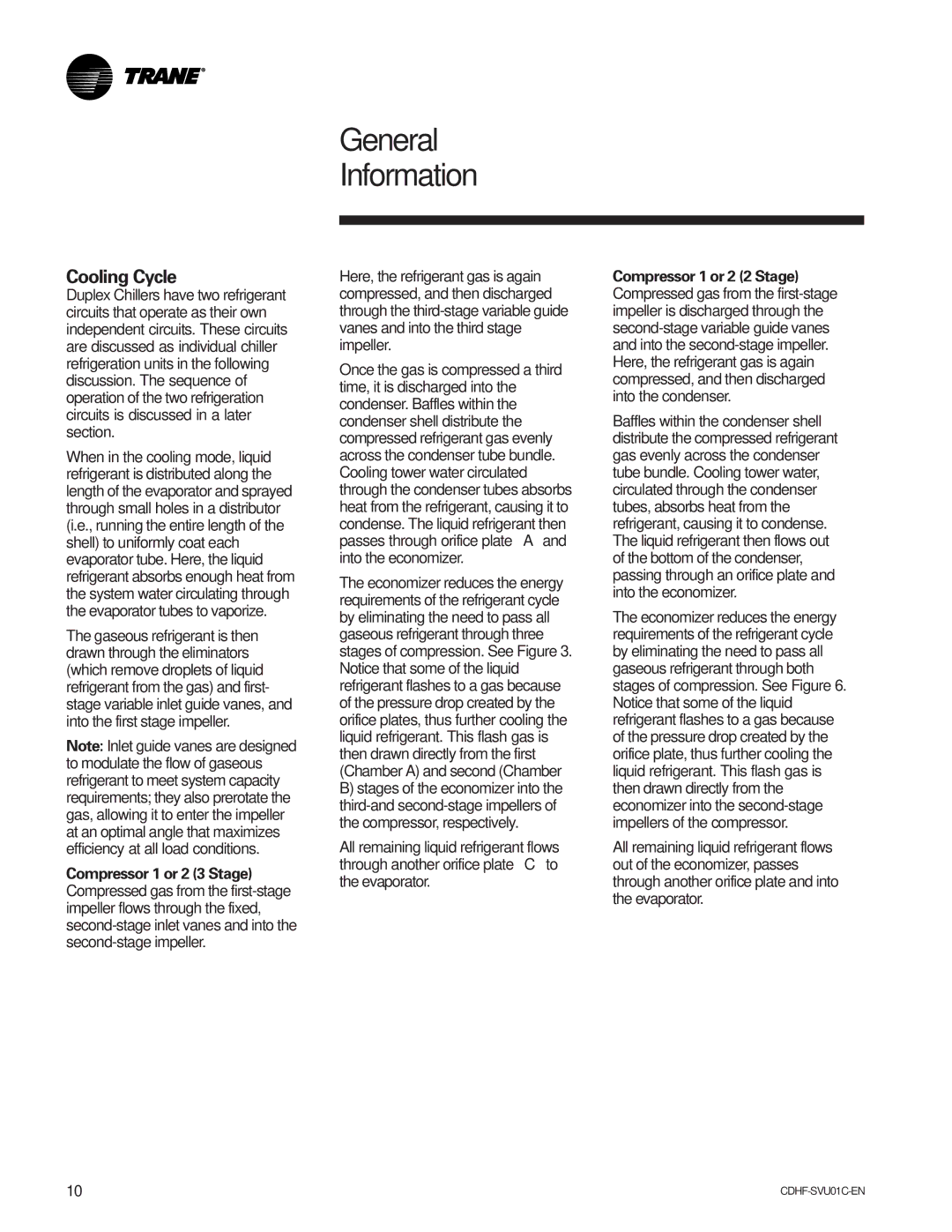
General Information
Cooling Cycle
Duplex Chillers have two refrigerant circuits that operate as their own independent circuits. These circuits are discussed as individual chiller refrigeration units in the following discussion. The sequence of operation of the two refrigeration circuits is discussed in a later section.
When in the cooling mode, liquid refrigerant is distributed along the length of the evaporator and sprayed through small holes in a distributor (i.e., running the entire length of the shell) to uniformly coat each evaporator tube. Here, the liquid refrigerant absorbs enough heat from the system water circulating through the evaporator tubes to vaporize.
The gaseous refrigerant is then drawn through the eliminators (which remove droplets of liquid refrigerant from the gas) and first- stage variable inlet guide vanes, and into the first stage impeller.
Note: Inlet guide vanes are designed to modulate the flow of gaseous refrigerant to meet system capacity requirements; they also prerotate the gas, allowing it to enter the impeller at an optimal angle that maximizes efficiency at all load conditions.
Compressor 1 or 2 (3 Stage) Compressed gas from the
Here, the refrigerant gas is again compressed, and then discharged through the
Once the gas is compressed a third time, it is discharged into the condenser. Baffles within the condenser shell distribute the compressed refrigerant gas evenly across the condenser tube bundle. Cooling tower water circulated through the condenser tubes absorbs heat from the refrigerant, causing it to condense. The liquid refrigerant then passes through orifice plate ‘‘A’’ and into the economizer.
The economizer reduces the energy requirements of the refrigerant cycle by eliminating the need to pass all gaseous refrigerant through three stages of compression. See Figure 3. Notice that some of the liquid refrigerant flashes to a gas because of the pressure drop created by the orifice plates, thus further cooling the liquid refrigerant. This flash gas is then drawn directly from the first (Chamber A) and second (Chamber
B)stages of the economizer into the
All remaining liquid refrigerant flows through another orifice plate ‘‘C’’ to the evaporator.
Compressor 1 or 2 (2 Stage)
Compressed gas from the
Baffles within the condenser shell distribute the compressed refrigerant gas evenly across the condenser tube bundle. Cooling tower water, circulated through the condenser tubes, absorbs heat from the refrigerant, causing it to condense. The liquid refrigerant then flows out of the bottom of the condenser, passing through an orifice plate and into the economizer.
The economizer reduces the energy requirements of the refrigerant cycle by eliminating the need to pass all gaseous refrigerant through both stages of compression. See Figure 6. Notice that some of the liquid refrigerant flashes to a gas because of the pressure drop created by the orifice plate, thus further cooling the liquid refrigerant. This flash gas is then drawn directly from the economizer into the
All remaining liquid refrigerant flows out of the economizer, passes through another orifice plate and into the evaporator.
10 |
